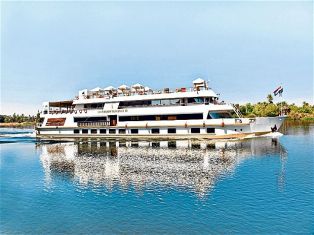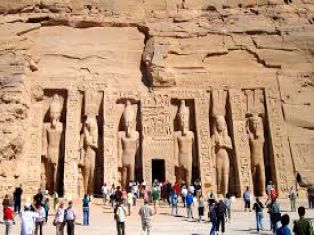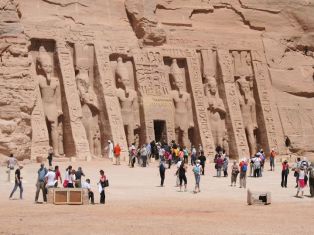Valley of the Kings
General Info
At the dawn of Egypt’s new kingdom a line of Theban princes initiated an era which would carry Egypt to a level of power unequalled in her history and which would continue, essentially unbroken,for500 years,
The Valley of the Kings has excited the interest and, imagination of countless visitors over thousands of years, and for one reason it stands without equal as the most magnificent burial ground the world has ever seen.
The valley is deep, much-riven cleft in the limestone hills with shear walls and with many side valleys, dominated by Gabal al Qurna ( hill of the horn ) to the south west, is known today as Wadi Biban el- mulk, the valley is sacred to the local goddess mertseger ( she who loves silence ),
The valley contains 63 tombs, available to visiting about 9 tombs. its located on the west bank of the Nile, as the ancient Egyptians used to call the west side of the Nile the city of the dead, and the reasons why they choose the west bank and the mountain to be their burial site are.
1-They believed when the sun rise in the east it means a new day or a new life, while when the set in the west it means the end of the day or the end of the life which is sensible for them.
2-The weather in the west is hot and this will keep their mummies preserved for the afterlife.
3-The hill is a suitable location to hide their tombs and keep mummies away from the robbers, but later it proved it’s not safe as they imagined, after most of the tombs were robbed.
After the expulsion of the Hyksos, the Theban rulers of the 18th dynasty continued the tradition of burial at Thebes ,Tuthmosis I was the first king to choose this location for his burial, his successors of the new kingdom 18th,19th and 20th dynasties followed his lead, the construction plan of the majority of the tombs are simple and much similar, entrance leading to a series of passages with side chambers and at the end of the tomb is the burial chamber ,but some of the tombs has a shaft or wall, there are many theories about the shaft, some believe to deceive the robbers in giving them the impression that this is the end of the tomb, while other believe as it Is a connection between life and afterlife where the soul of the deceased king
will join the gods of the underworld via this shaft, and the last theory is about accumulating the rain water, the walls of these tombs were decorated from top to bottom with mysterious guides to the underworld, and their chambers filled to overflowing with treasures of ritual daily life.
Stages of Work in the royal tombs:
Selecting the location for a tomb: when the new pharaoh was crowned, his vizier, chief stonemason and architect visit the valley with intention of choosing a site for the new tomb, their choice then had to be approved by the king himself, once confirmation was received, the foundation ritual was carried out and the foundation deposits were placed.
Construction of The Tomb:
the construction began by the removal of surface materials to reach
The bedrock, then the workers cut the entrance doorways, passages and chambers, other craftsmen.
Smooth the floor, walls and ceiling, debris and stone chips were removed in baskets, the walls were then polished and any gaps or cracks were plastered, and a fine layer of plaster added to the surface stone ,then draftsmen sketched outlines of figures and representations in red paint, after some of the scenes being corrected in black paint, then the sculptors and painters filling in the reliefs and background, it seems that the work was carried out by two teams working in two shifts with a midday break, the first day of work was recorded on papyrus and ostraca by scribes, there were no waiting for a stage to be completed before the next phases of the work to commence.
Illumination: the reflected sunlight was used near the entrance of the tombs in the first passages, while candles and oil lamps with wicks were used to illuminate the depth of the tomb.
The ancient Egyptians in their search for resurrection, they used mummification to preserve their bodies after death in order to guarantee everlasting life, the chief embalmer was a priest wearing a mask of Anubis. Anubis was the jackal headed god of the dead. He was closely associated with mummification and embalming, hence why priests wore a mask of Anubis. The mummification process started as follow:
- Frist his body is taken to the tent known as ‘ibu’ or the ‘place of purification’. There the embalmers wash his body with good-smelling palm wine and rinse it with water from the Nile.
- One of the embalmer’s men makes a cut in the left side of the body by a flint knife and removes many of the internal organs.it is important to remove these because they are the first part of the body to decompose, the liver, lungs stomach and intestines are washed and packed in natron which will dry them out, the heart is not taken out of the body because it is the center of intelligence, feeling and the man will need it in the afterlife.
- The brain is removed via nostrils with an iron hook, and what cannot be reached with the hook is washed out by the drugs.
- The body is now stuffed with natron which will dry it out, sewn up again, and after that the body placed in natron and covered for 70 days never longer.
- When this period is over, the body is washed and wrapped from head to foot in linen, then the body is given back to the family, who has a wooden case made shaped like human figure to keep the body inside.
6-The final step is the treatment ,no incision is made ,oil cedar is injected with a syringe into the body through the anus which is afterwards stopped up to prevent the liquid from escaping ,after this treatment ,the body returned to the family without further attention.
In the past ,when the internal organs were removed from a body they were placed in canonic jars over many years the embalming practices changed and embalmers began returning internal organs to bodies After the organs had been dried in natron. however, solid wood or stone canopic jars were still buried with the mummy to symbolically protect the internal organs, The 4 canopic jars, one human, one a jackal, on a hawk and the last one a baboon, representing the 4 sons of the god hours symbolizing the 4 attendant spirits of the dead, the jars were placed in a single container near the mummy.
The Egyptian texts agree with Herodotus that, that mummification took a total of 70 days, with 40 days used for the drying ,the BIBLE (Genesis 50) agree with a period of 40 days for the actual drying when referring to the burial of Jacob.
After the mummification process is completed, they add some amulets, like ‘Isis knot’ amulet which will protect the body and the ‘plumet’ amulet which will keep the person balanced in the next life, then a priest reads spells out loud while the mummy is being wrapped. These spells will help ward off evil spirits and help the deceased make the journey to the afterlife, and a picture of the god Osiris is painted on its surface, finally, a large cloth is wrapped around the entire mummy.it is attached with strips of linen that run from the top to the bottom of the mummy, and around its middle. A board of painted wood is placed on top of the mummy before the mummy is lowered into its coffin. The first coffin is then put inside a second coffin and transfer the body to the west bank where the funeral is held for the deceased and his family mourns his death, and on sledges they place the mummy inside the tomb in the valley of the kings and the last step before leaving is one of the most important ritual called the opening mouth ritual, the ancient Egyptians believed that in order for a person’s soul to survive in the afterlife it would need to have food and water. The opening of the mouth ritual was thus performed so that the person who died could eat and drink again in the afterlife.
The ancient Egyptians decorated their homes, gardens, palaces and tombs with impressive works of art which reflected their appreciation for all that the gods had given them and accented these depictions with vibrant colors, each color was created by mixing various naturally occurring elements and each became standardized in time in order to ensure uniformity in art work. - Red made from oxidized iron and red ocher ,used to create flesh tones and symbolizing life but also evil and destruction. Red was associated with both fire and blood and so symbolized vitality and energy but could also so used to accentuate a certain danger or define a destructive deity.
- Blue one of the most popular colors, commonly referred to as ‘’Egyptian blue made from copper and iron oxides with silica and calcium, symbolizing fertility ,birth ,rebirth, life and usually used to depict water and the heavens.
- Yellow made from ocher and oxides originally but, from the new kingdom (c1570-1069 BCE) was mixed from arsenic trisulphide and symbolizing the sun and eternity.
- Green mixed from malachite, a copper mineral and symbolizing goodness, growth, life, the afterlife, and resurrection. The Egyptian afterlife was known as the field of reeds and, in some eras, as the field of malachite and was always associated with color green.
- White made from chalk mixed with gypsum, symbolizing purity, sacredness, cleanliness and clarity.
- Black made from carbon, ground charcoal, mixed with water and sometimes burnt animal bones, symbolized death, darkness, the underworld and resurrection.
These basic colors were often mixed, diluted or otherwise combined to create colors such as purple, pink, teal, gold, silver and other hues. Artists were not bound by the minerals they mixed their paints from but only by their imaginations and talent in creating the colors they needed to tell their stories. The walls of the tombs are decorated with the mysterious guide to the underworld, one of the most important books is the Amduat (‘’that which is in the afterworld’’), or the ‘’text of the hidden chamber which is in the underworld and ‘’ book of what is in the underworld’’) is an important ancient Egyptian funerary text of the new kingdom. like many funerary texts, it was found written on the inside of the pharaoh’s tomb for reference, it tells the story of Ra ,the Egyptian sun god who travels through the underworld, from the time when the sun sets in the west and rises again in the east. It is said that the dead pharaoh is talking this same journey, ultimately to become one with Ra and live forever. The underworld is divided into twelve hours of the night, each representing different allies and enemies for the pharaoh/sun god to encounter. The Amduat names all of these gods and monsters. The main purpose of the Amduat is to give the names of these gods and monsters to the spirit of the dead pharaoh, so he can call upon them for help or use their name to defeat them. The hours:
In hour 1 the sun god enters the western horizon (Akhet) which is a transition between day and night.
In hours 2 and 3 he passes through an abundant watery world called (wernes)
And (the waters of Osiris).
In hour 4he reaches the difficult sandy realm of (Sokar), the underworld hawk deity, where he encounters dark zig zag pathways which he has to negotiate, being dragged on a snake-boat.
In hour 5 he discovers the tomb of Osiris which is an enclosure beneath which is hidden a lake of fire, the tomb is covered by a pyramid like mound (identified with the goddess Isis) and on top of which Isis and Nephthys have alighted in the form of two kites (birds of prey). In the sixth hours the most significant event in the underworld occurs. The Ba or (soul) of Ra unties with his own body, or alternatively with the Ba of Osiris within the circle formed by the mehen serpent. This event is the point at which the sun begins its regeneration; it is a moment of great significance, but also danger, as beyond it.
In hour 7 the adversary Apep (Apophis) lies in wait and has to be subdued by the magic of Isis, and the strength of set assisted by Selket. Once this has been done the sun god opens the doors of the tomb in hour 8 and then leaves the sandy island of Sokar by rowing vigorously back into waters in hour 9.
In hour 10the regeneration process continues through immersion in the waters until hour 11the god’s eyes (a symbol for his health and well-being) are fully regenerated.in hour 12 he enters the eastern horizon ready to rise again as the new day’s sun.
The ancient Egyptian believed what you do in your current life effects what happens to you in the afterlife. This usually takes the form of judgment by a deity, where the god Osiris, the god of the afterlife, weighed the person’s heart on a scale against the feather of Ma’at, the goddess of order, truth and righteousness. If the heart weighed more than the feather, meaning that the person was more wicked than good, then the heart would be devoured by Ammit, a demon with the head of a crocodile, the front half of the body of leopards, and the back half of a hippopotamus, but with goat arms. if a person’s heart was devoured by Ammit, then he would die a second death and be completely annihilated from existence, and if the heart weighed less than the feather, meaning that the person was good and will join the gods of the gods of the underworld to heavens which they imagined as green fields, known as (Eiarru) usually was placed in the east, where the sun rises, and described as boundless reed fields, like those of the earthly nile delta. this ideal hunting and farming ground allowed the souls here to live for eternity.
recommended tours

Private Half - Day Tour: Philae Temple - Unfinished Obelisk & High Dam



